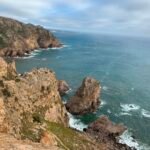Greece, boasting the Aegean Sea, is a true “thousand-island nation,” with a total of 6,000 islands. Brilliant sunshine, romantic islands, passionate local customs, and mesmerizing scenery have made Greece a tourist hotspot. In the summer, visiting the Greek islands to enjoy the sunshine has become the top vacation choice for many Western tourists. Among the numerous islands, the one most familiar to us is the fairy-tale-like romantic “Honeymoon Island” – Santorini. Santorini Island is located approximately 200 kilometers southeast of mainland Greece, historically and alternatively known as Thira. The name “Santorini,” now well-known to the world, was given by Venetians in the 13th century in honor of Saint Irene. It is the largest island in the Santorini archipelago, covering an area of about 73 square kilometers with a population of approximately 160,000. Over 3,600 years ago, a massive volcanic eruption occurred here, causing part of the island to sink into the sea, leaving behind a huge volcanic crater and several hundred meters of volcanic ash. It is speculated that this eruption was one of the causes of the decline of the Minoan civilization on Crete. This volcanic eruption altered Santorini’s natural landscape, and today, houses built along the cliffs stretch endlessly, offering expansive and self-contained scenic views.
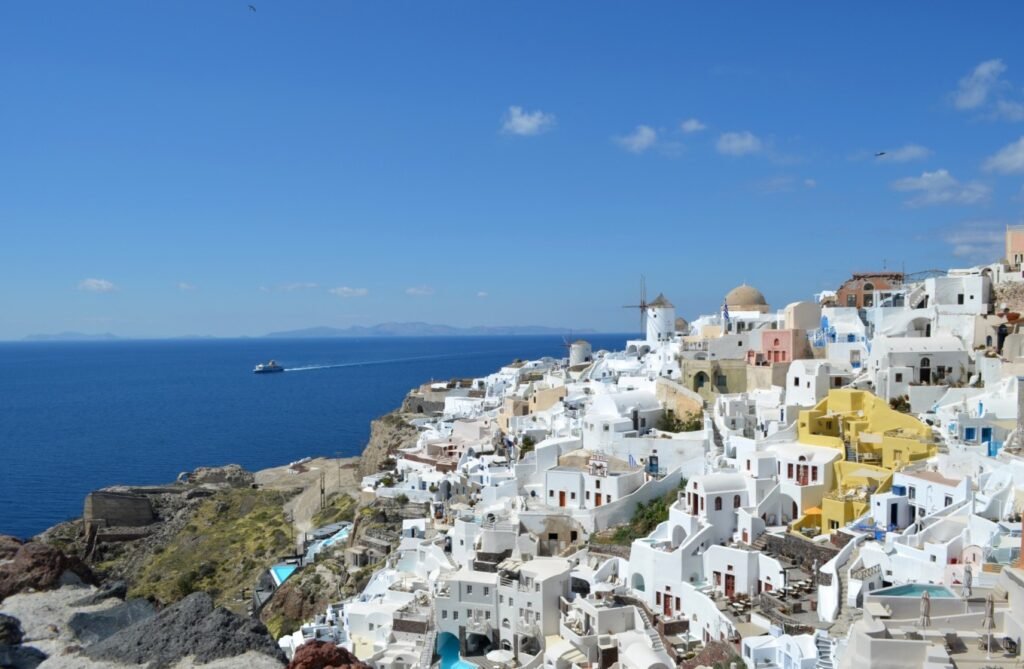

Santorini Island is not large in area, but it boasts an airport that greatly facilitates the arrival of tourists from around the world. The airport is very small, with check-in counters almost immediately upon entering, and the only café offering light meals is located outside the airport. If traveling from Athens to Santorini, in addition to flying, you can also take a boat. From Athens’ Piraeus Port to Santorini Island, a slow boat takes about 8 hours, while a fast boat takes just over 4 hours. Although traveling by boat allows you to enjoy the beautiful sea views along the way, you also need to consider the weather and the possibility of seasickness. These ferries are not very large and are not as stable as cruise ships. We happened to catch a boat during windy and stormy weather. Although the sky was clear and the sea was a brilliant blue, we could clearly feel the boat’s rocking. A memorable moment was when, nearing Santorini, we experienced a few seconds of weightlessness caused by the boat’s swaying. For tourists who do not get seasick, this can be an exciting “riding the waves” sensation, while for friends feeling unwell, it was quite a challenge.
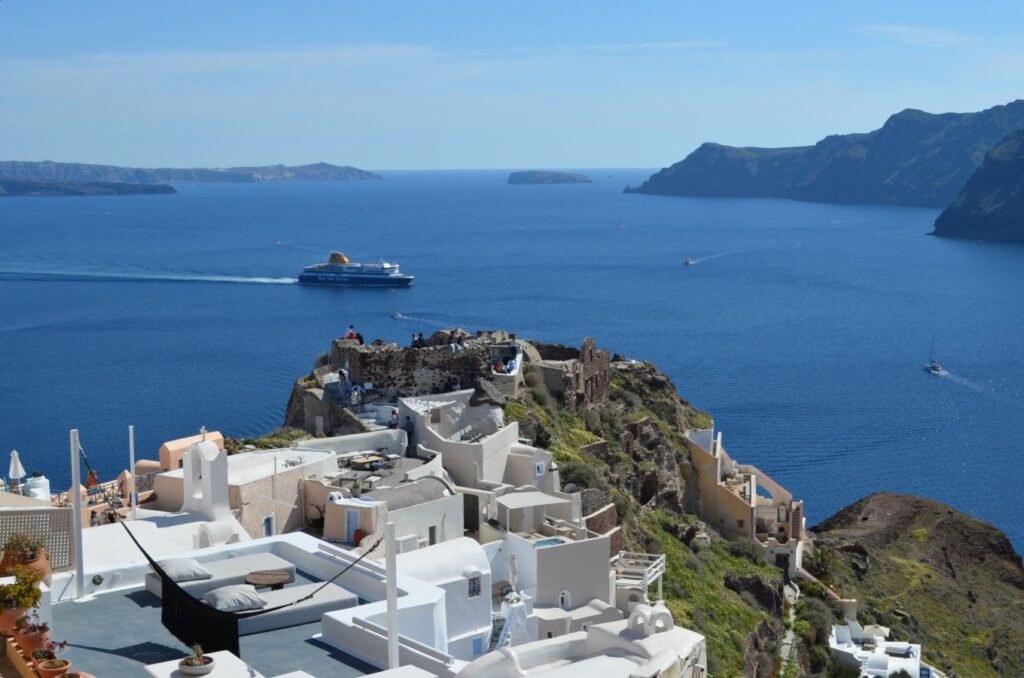
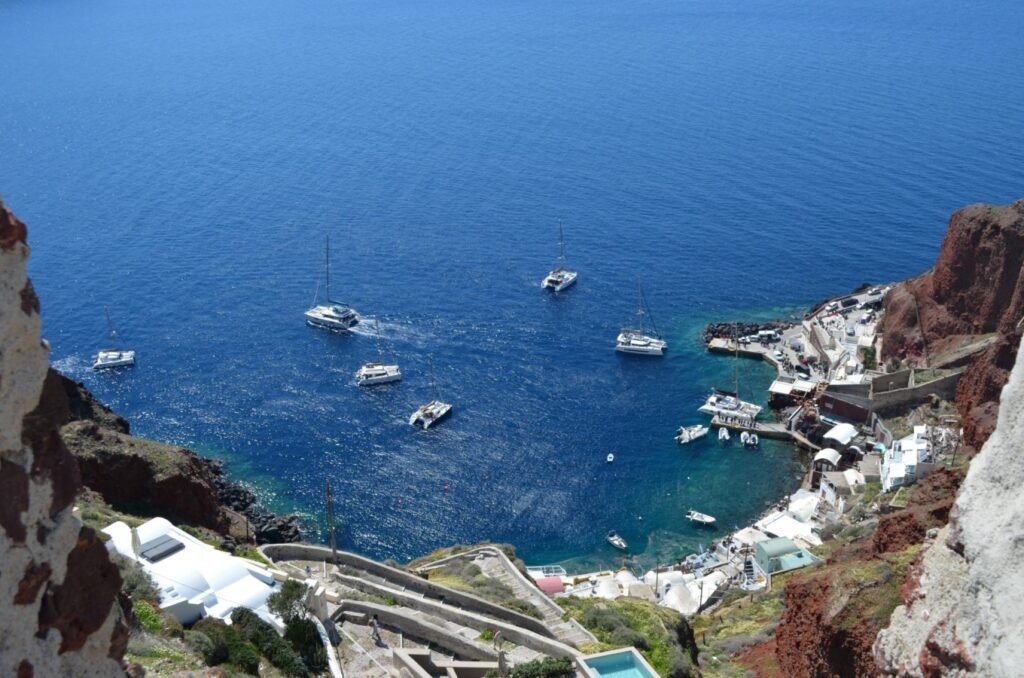
For first-time visitors to the island, Santorini offers two main accommodation options: one is the island’s center, Fira, and the other is Oia, often featured in magazines as the “most beautiful sunset spot.” I chose to stay in Fira, as it serves as the island’s transportation hub. From Fira’s bus station, buses connect to various destinations, making it highly convenient. Additionally, it is relatively close to both the port and the airport, and as the capital of Santorini, Fira boasts well-developed commercial facilities, providing great convenience for daily needs. Although it is the capital, the city center is quite small—walking just ten minutes from the center already feels like venturing into the outskirts. The streets are lined with restaurants, souvenir shops, jewelry stores, and more, revealing that tourism has become the backbone of the local economy.
What left the deepest impression on me in Fira were the cliffside restaurants and bars. I arrived in Fira in the evening, and the host recommended several cliffside restaurants where one could dine while watching the sunset. However, exhausted from travel, I didn’t venture out that evening. The next day, as I took a stroll, I was stunned by the expansive views and picturesque scenery before my eyes. These whitewashed buildings, interspersed with bright colors, are iconic of Santorini. Most of them cater to tourists as accommodations, though some are local residences. The cliffside area, with its unparalleled views, is filled with “sea-view rooms,” many of which feature spacious dining terraces open to guests. In addition to enjoying scenic walks, one can easily find a table to sit down, order a drink or a glass of wine, and take in the sea, where every day feels like spring. The island’s architecture, predominantly white, stands out against the blue sky and the Aegean Sea, exuding purity and romance. Occasionally, a splash of yellow appears, vibrant and cheerful, perfectly complementing the blue sky.
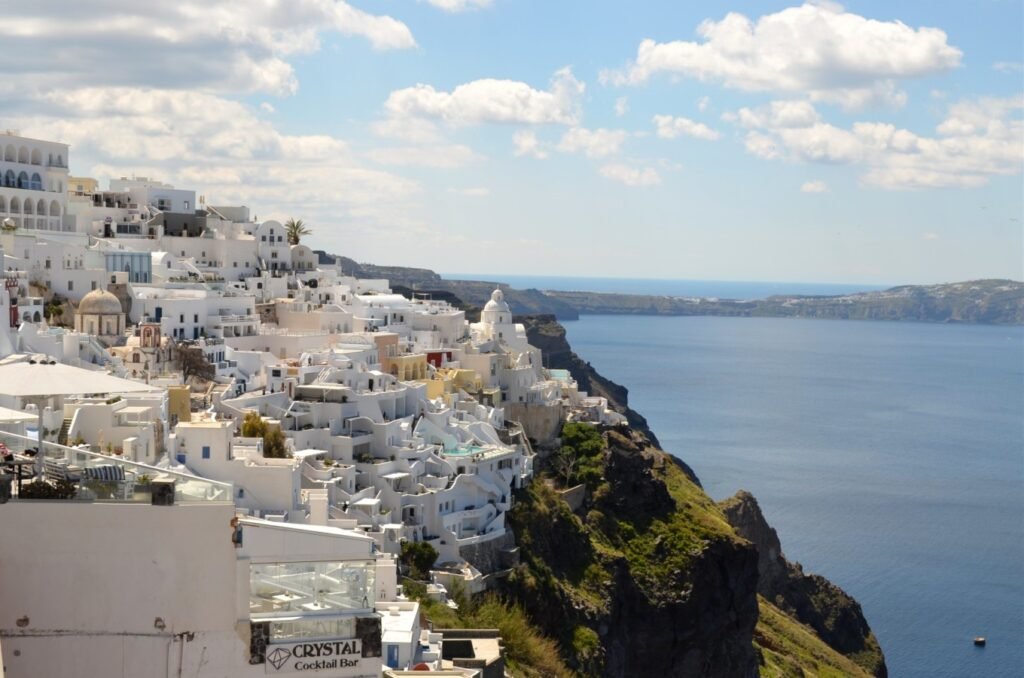
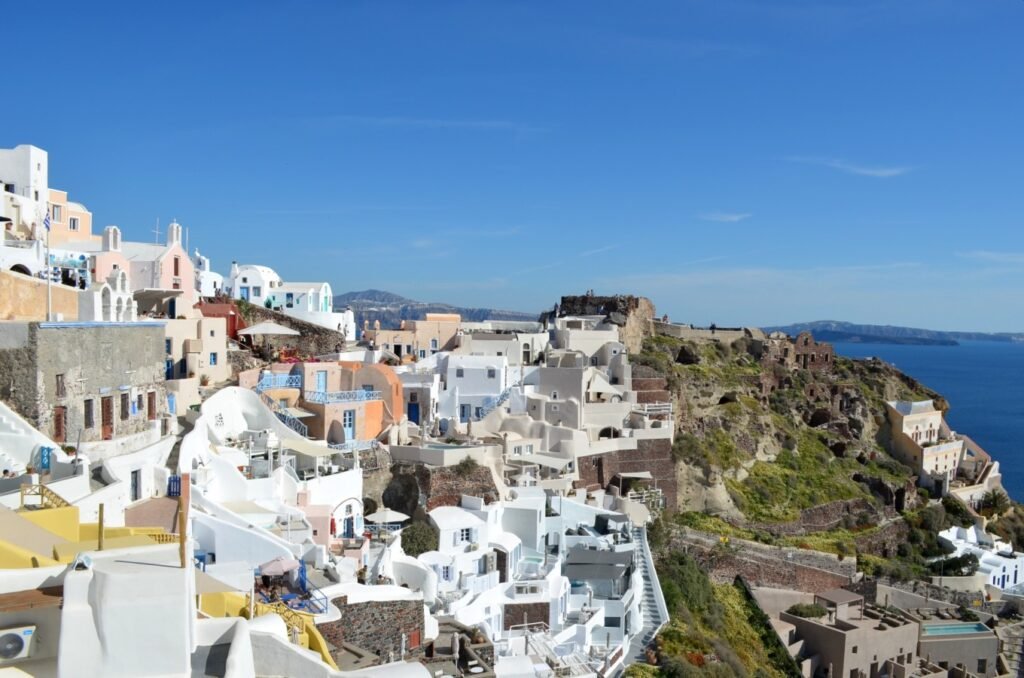
A more “luxurious” and romantic option is to dine at a restaurant with an exceptional view. In April, Santorini is just entering the tourist season, and the number of visitors remains moderate. At midday, many seats on the seaside side of the restaurant are still available for selection. The moment we sat down, we were greeted by an unobstructed, expansive view. To the left lay a series of “cave hotels” adorned with bright accents amidst the whitewashed surroundings. In front of us stretched the serene, blue Aegean Sea, shimmering under the sunlight like silk. A large cruise ship drifted slowly across the water, birds circled overhead, and the breeze was gentle and pleasant.
The breathtaking beauty of this scenery made us forget time, place, and even ourselves for a moment. It wasn’t until I caught the smiling gaze of the waiter that I remembered we still had to order. On the right side of the image below is the small island of Nea Kameni, an uninhabited volcanic island located near Fira. In the city center, travel agencies offer half-day tours to explore this volcanic island.

Oia, located in the northern part of Santorini, is the most famous spot on the island, attracting nearly every visitor in search of the iconic blue-domed churches and the renowned sunset. Although it is written as “Oia,” locals informed us that the “O” is silent, so it is pronounced as “Ia.”
Getting to Oia from Fira is very convenient. The bus station displays timetables for each route, and buses run frequently, taking about 20 minutes to reach Oia. An amusing experience happened while we waited for the bus: a group of local schoolchildren arrived, and the bus driver, an elderly man, made sure the students boarded first, weaving through the crowd of tourists. At first, the tourists were confused, but with the driver’s loud calls of “student first” in his thick Greek accent, everyone quickly understood that this bus route was not only for tourists.
Oia is compact, and half a day is enough to explore it leisurely. The stone-paved alleys, winding and charming, vary between bustling and tranquil. The buildings, predominantly white, blend harmoniously with the blue sea and sky, with playful splashes of yellow and peach adding liveliness. Some of the alleyways are lined with local homes, while others host small shops offering a variety of artwork and souvenirs, where visitors can admire the creative, whimsical works of local artists.
The town is also home to many cats, seemingly accustomed to human company. They stroll about nonchalantly or lounge comfortably, showing neither caution nor fear, embodying the easygoing spirit of this picturesque place.
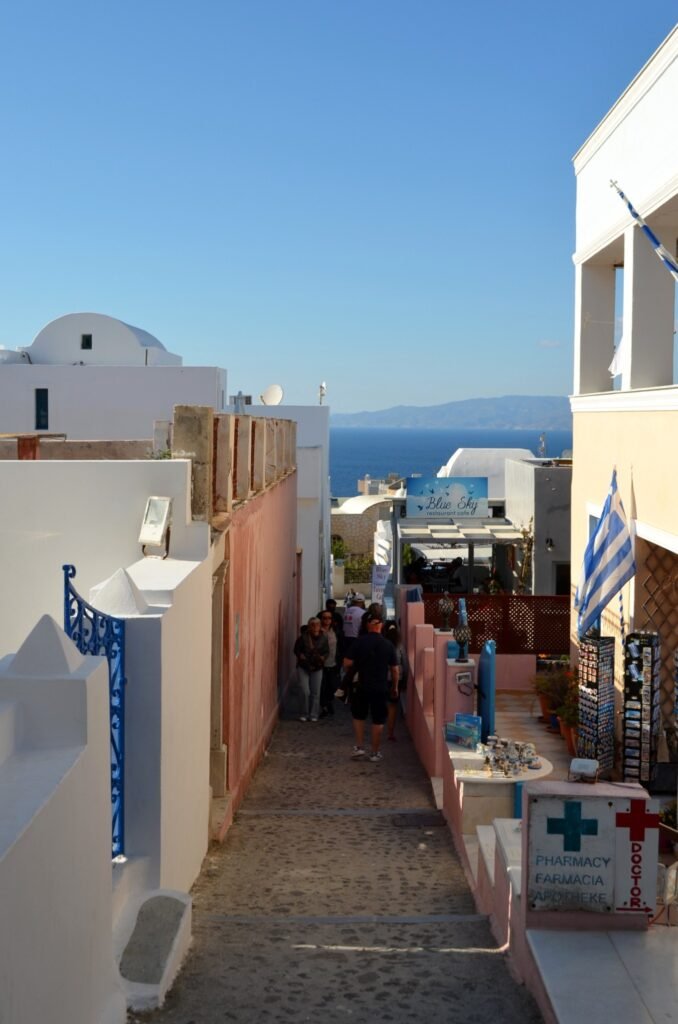
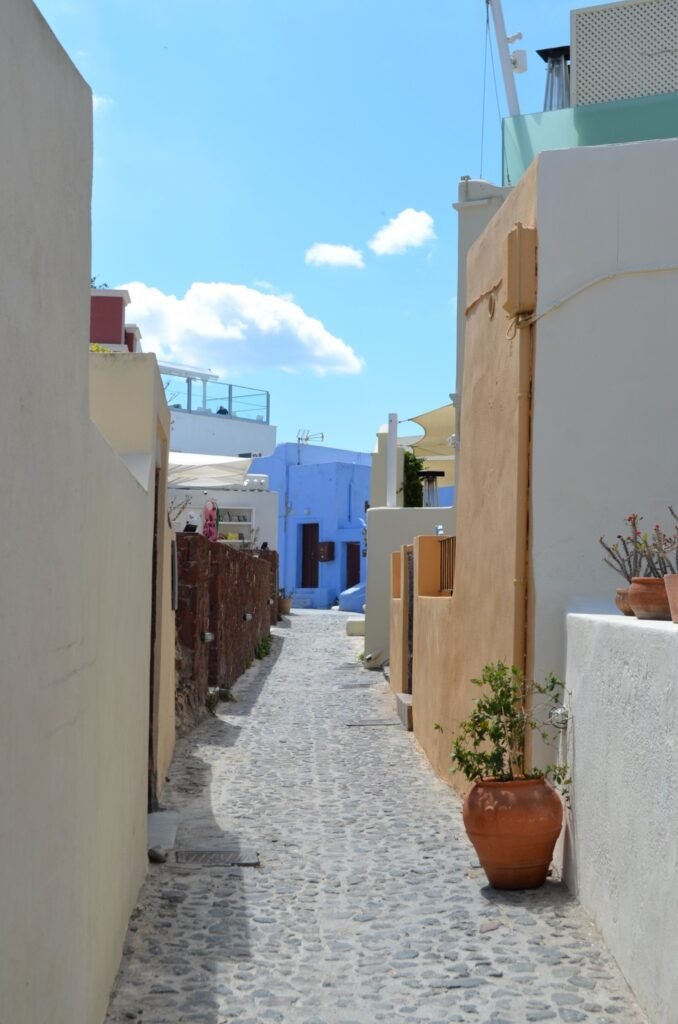
Even for those who have never visited Santorini, the island’s iconic “blue-domed churches” are likely familiar. The combination of white walls and blue domes is a characteristic feature of local churches. However, it was a photograph from National Geographic that propelled these blue-domed churches to global fame, turning them into a must-see destination for countless visitors. The famous photograph was actually taken in Firostefani, a small village near Fira.
That said, Oia is also home to many blue-domed churches, where the striking blend of blue and white evokes the quintessential Greek aesthetic. Set against the backdrop of the endless blue sky and Aegean Sea, these picturesque structures feel like scenes from a dreamy fairytale.
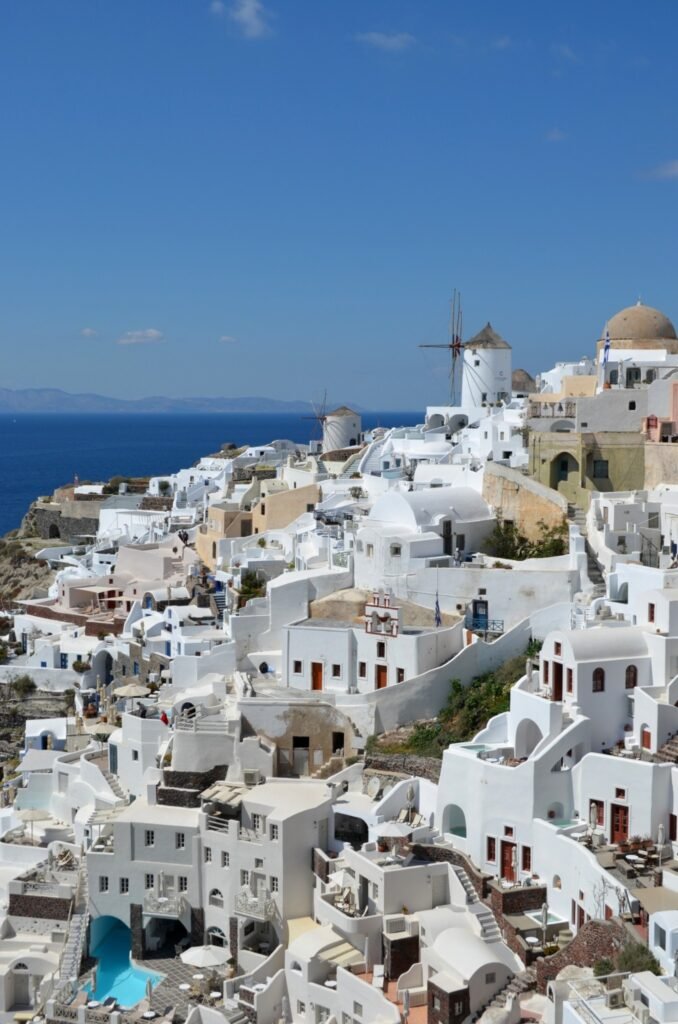

In the town of Oia, the sunset is an experience not to be missed. It is renowned as one of the most beautiful places to watch the sunset. As the intense sunlight gradually softens and a refreshing coolness fills the air, visitors from around the world gather on the scenic heights, waiting quietly for the sun to dip below the horizon. In addition to standing at the high viewpoints, one can also enjoy the view from a restaurant below, savoring food and drinks while waiting for the romantic spectacle. Another option is to rent a small yacht and witness the sunset directly from the Aegean Sea.
As the sky begins to blush with shades of red, both the tourists on the island and those on boats across the sea are captivated by nature’s display. Every moment brings a shift in light and scenery, as if an unseen hand is painting layers of orange-red hues across the vast canvas of the sky. At the peak of the sunset’s brilliance, a beam of natural light stretches across the water, where a sailboat drifts gracefully within this radiant spotlight, adding a poetic and picturesque touch to the magnificent and romantic scene.
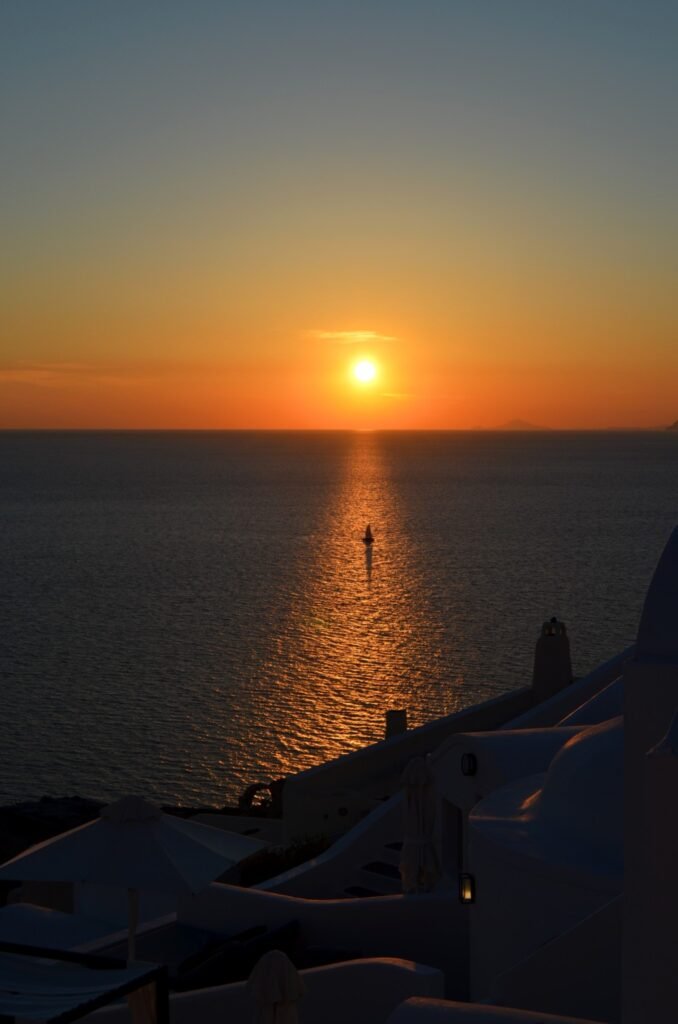
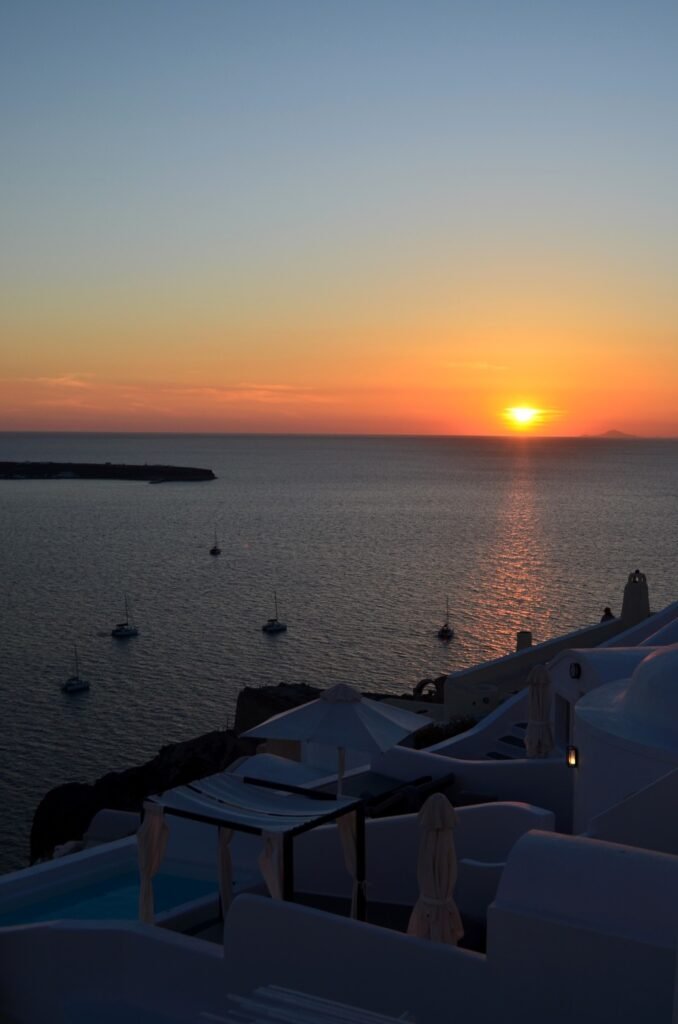
When the sun fully dips below the horizon, leaving the sky tinged with soft shades of pink and blue, the crowd gathered atop the viewpoint begins to stir. Some head towards the restaurants and bars with joyful smiles, ready to embark on a new round of celebration, while others, still savoring the experience, prepare to leave Oia and begin their journey back home.
A place as picturesque as this, combined with enticing cuisine, truly offers the perfect finishing touch.
Delicious Food, Wine, and Stunning Views
Due to Santorini’s unique geography, many ingredients need to be transported by sea, and with tourism thriving on the island, prices are generally higher than on mainland Greece. However, even with these conditions, Fira boasts a few local eateries that offer both excellent flavors and affordable prices. These places serve traditional Greek fast foods, such as pita wraps, salads, and skewers, and their reputation spreads by word of mouth across the island.
Before these small shops open at noon, lines are already forming, and they remain busy until closing time. Seating is often limited, but that doesn’t deter anyone; people casually stand outside or sit on the ground, with many choosing to order food to-go. I had no particular expectations for these street food joints, but the pork skewers I tried completely blew me away—they were the most tender and flavorful souvlaki I had ever tasted in Greece.

Santorini’s cuisine does not differ much from that of mainland Greece, but as an island, seafood naturally takes center stage. We discovered a highly recommended seafood restaurant, where the seafood platter left a lasting impression. The fried baby squid and calamari were perfectly crispy on the outside and tender inside, enhanced by a splash of lemon juice that added a refreshing zest. Grilled fish and shrimp were cooked to perfection, and the mussels were sweet and succulent. With fresh ingredients and simple, authentic cooking methods, we found ourselves nodding in silent approval as we enjoyed each bite.
As a starter, we ordered thinly sliced, crispy fried eggplant, which reminded me of the eggplant fritters my family used to make when I was a child. In another restaurant in Oia, we savored a seafood pasta, where the rich, flavorful broth and fresh ingredients combined to create a dish so memorable that I still find myself craving it.
Greece is also one of my favorite countries for eggplant dishes. In Santorini, we tried more of the crispy fried eggplant slices, delighting in their familiar taste. One of the most famous Greek dishes featuring eggplant is Moussaka, popular across the Balkans and the Middle East but best known in Greece. Similar to lasagna, moussaka uses layers of eggplant as the base, often combined with ground meat, and sometimes with potatoes or zucchini. The top layer consists of a rich mixture of cheese, flour, and milk, baked to golden perfection.
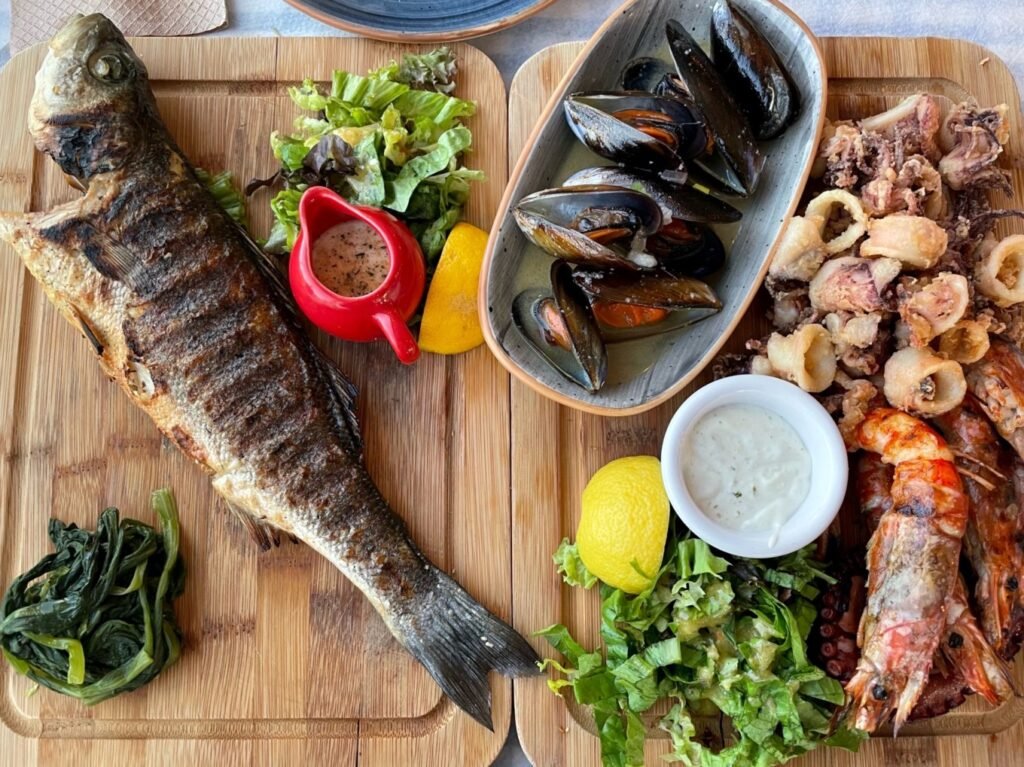
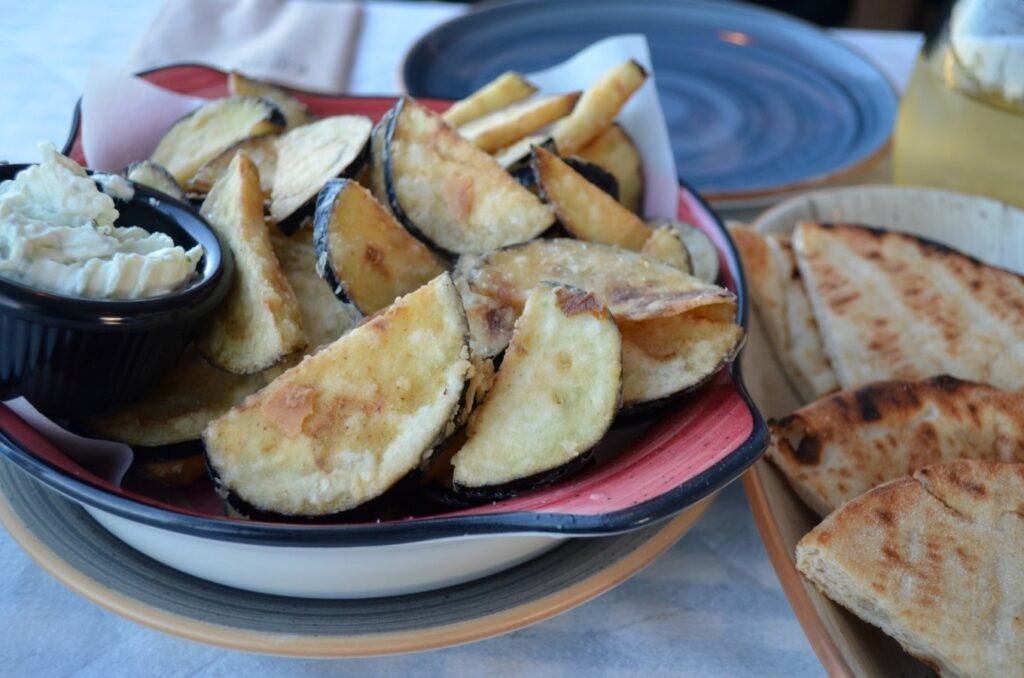
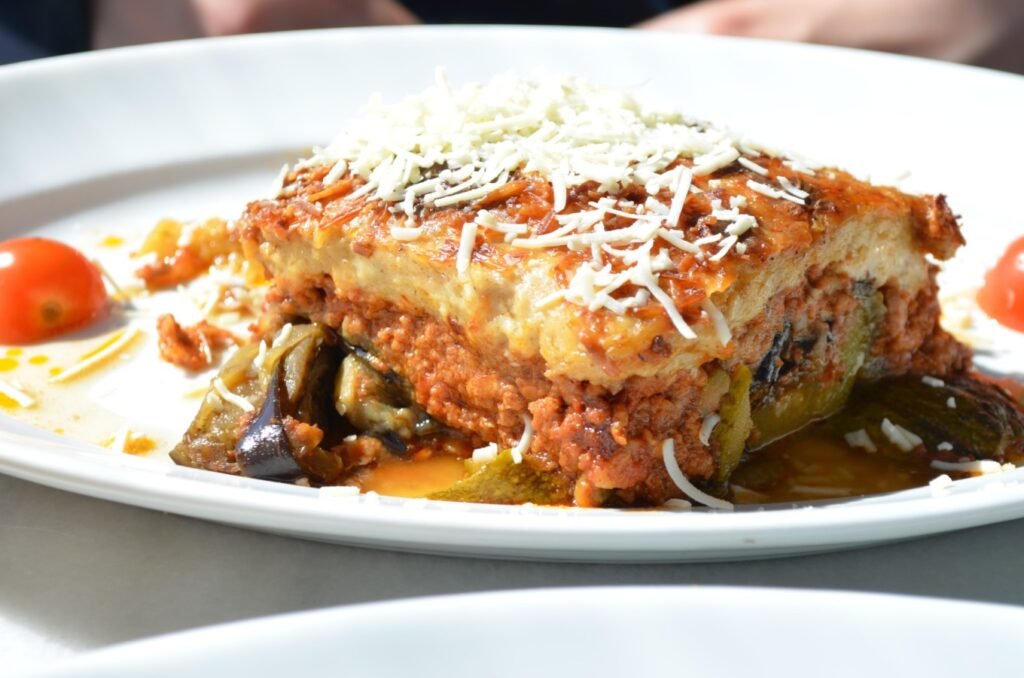

In addition to its delightful cuisine, Santorini’s wines are also worth savoring. The island’s unique climate and volcanic soil have nurtured grape varieties found only here. Influenced by the Republic of Venice, Santorini’s winemaking tradition dates back to the Middle Ages, earning a distinguished reputation even in ancient times.
Santorini grows five main grape varieties. The white varieties include Assyrtiko, Athiri, and Aidani, while the red varieties are Mandilaria and Mavrotragano. Among them, Assyrtiko stands out, accounting for nearly 70% of the island’s grape production. This grape forms the basis of Santorini’s most renowned wines, celebrated for their crisp and mineral-rich character, shaped by the island’s unique terroir.
The landscape of Santorini is both majestic and gentle, romantic and dreamlike, carrying an intoxicating charm that no photograph can fully capture. Standing before the sunlit Aegean Sea, the volcanic islands, the cobblestone streets, and the distinctive architecture, one can’t help but pause to gaze deeply. The blue and white hues and picturesque views, like fleeting glimmers of beauty in life, may vanish in an instant but remain forever etched in the heart.
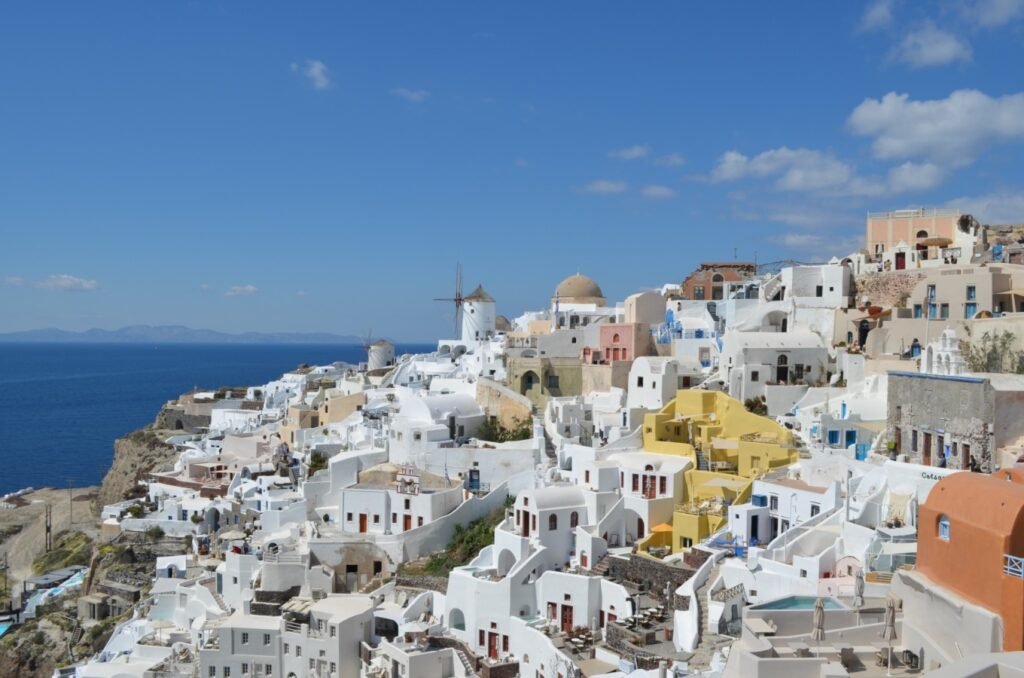
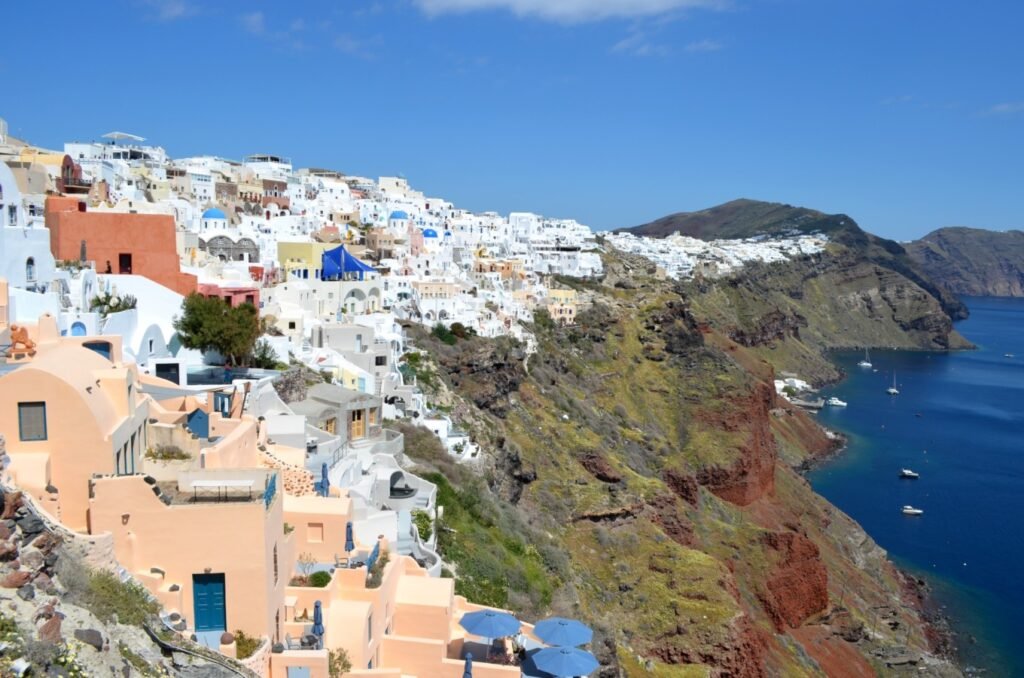
Travel Tips for Santorini (Non-Commercial Recommendations):
Clothing Advice:
Santorini’s tourism season starts to pick up in April, bringing plenty of sunshine and strong UV rays. While sunscreen is essential, check if indoor pools prohibit its use. The temperature fluctuates between day and night, so layering is advisable. Oia tends to feel slightly warmer than Fira.
Transportation Tips:
Travelers can reach Santorini by plane or ferry. Though ferries offer scenic views, those prone to seasickness should prepare in advance. You can book ferry tickets on websites like Ferryhopper; we took the Seajets high-speed ferry. To avoid discomfort, seasick passengers might consider upgrading to a more spacious upper deck, which cost us only 5 euros more.
Arrive at the port at least 30 minutes before departure, as some ports, such as Athens’ Piraeus, are large and complicated to navigate. Arriving early may also secure you a better seat.
From the Santorini port to Fira or Oia, you can take public buses, taxis, private transfers, or rent a car. The bus to Fira costs around 2 euros but runs infrequently, so patience is required. Taxis are scarce, often offering flat rates or attempting to overcharge. Expect a reasonable fare of 20-30 euros from the port or airport to Fira (10-15 minutes), with higher prices for trips to Oia.
The cheapest way to travel between Fira and Oia is by public bus. Buses run frequently, costing around 2 euros per trip. It’s best to arrive early to secure a seat, especially at peak hours. After watching the sunset in Oia, head to the bus stop early, as extra buses are often added to accommodate the crowds. Keep some change handy since bus tickets are sold in cash by the driver.
Accommodation Tips:
Staying in Fira offers convenient access to transportation.
Oia is another option, known for its iconic cave hotels.
Food Recommendations:
- For a budget-friendly Gyro wrap with tender meat, visit Yogi-Gyro (Fira).
- Try the seafood platter and fried eggplant at Parea Tavern (Fira).
- In Oia, Lotza offers delicious seafood pasta, moussaka, and spinach pies.
- Enjoy a meal with a stunning view at Aris Restaurant (Fira).
Shopping Advice:
- Take your time shopping—compare prices and don’t rush into purchases.
- APIVITA, a natural skincare brand, is widely available and reasonably priced in Greece.
- Be cautious when purchasing blue stones with white veins. While beautiful, they can turn black under sunlight and won’t return to their original color.

